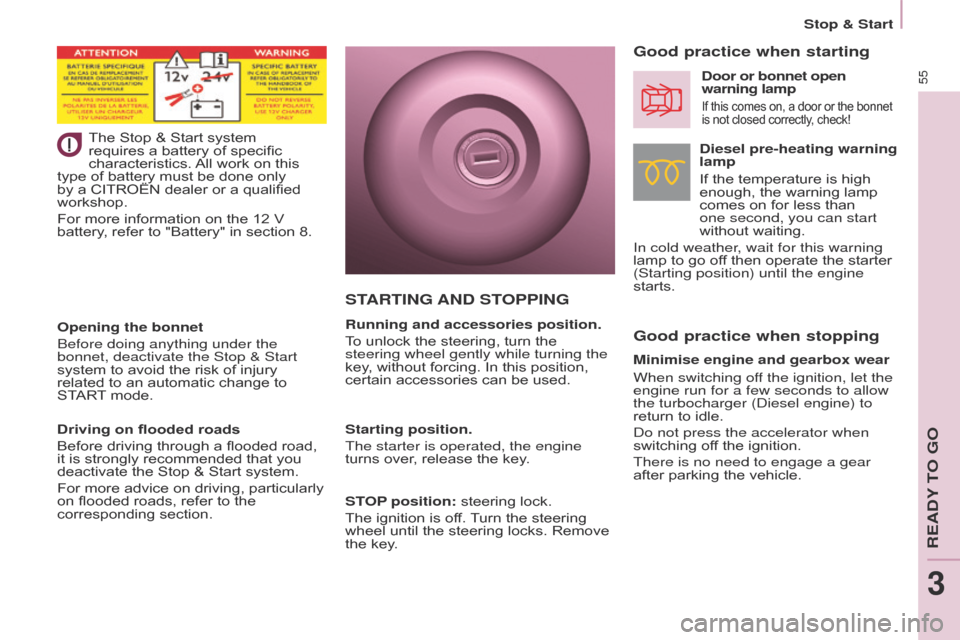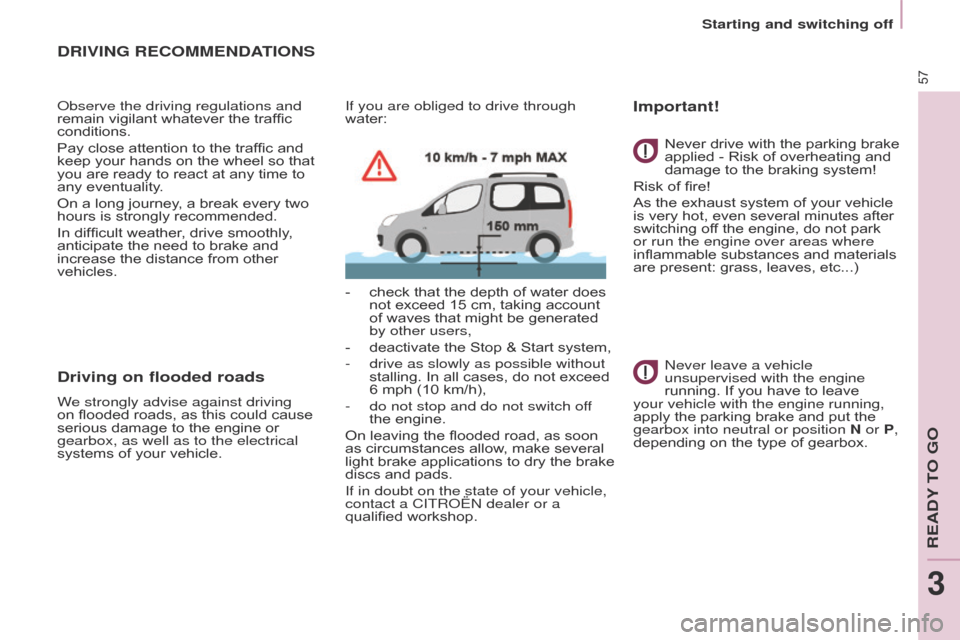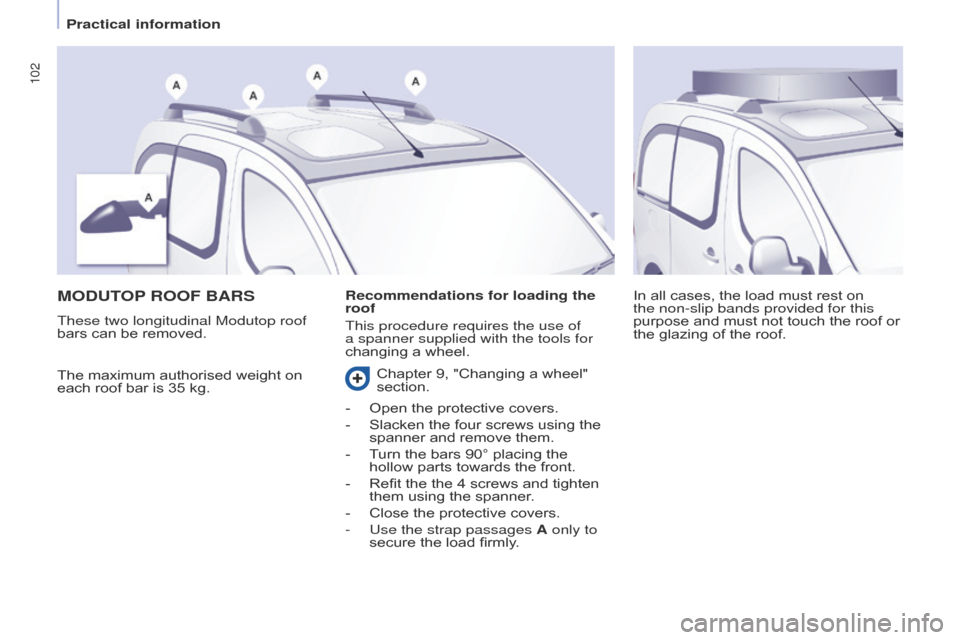wheel Citroen BERLINGO MULTISPACE 2016 2.G Owner's Guide
[x] Cancel search | Manufacturer: CITROEN, Model Year: 2016, Model line: BERLINGO MULTISPACE, Model: Citroen BERLINGO MULTISPACE 2016 2.GPages: 296, PDF Size: 10.36 MB
Page 57 of 296

55
Berlingo-2-VP_en_Chap03_Pret-a-partir_ed01-2016
The Stop & Start system requires a battery of specific
characteristics.
All
work on this
type
of battery must be done only
by
a
CITROËN dealer or a qualified
workshop.
For
more information on the 12 V
battery
, refer to "Battery" in section 8.
Good practice when stopping Good practice when starting
Diesel pre-heating warning
lamp
If the temperature is high
enough,
the warning lamp
comes
on for less than
one
second, you can start
without
waiting.
In cold weather, wait for this warning
lamp
to
go off then operate the starter
(Starting position) until the engine
starts.Door or bonnet open
warning lamp
If this comes on, a door or the bonnet is not closed correctly, check!
Minimise engine and gearbox wear
When switching off the ignition, let the
engine run for a few seconds to allow
the turbocharger (
d iesel engine) to
return
to idle.
d
o not press the accelerator when
switching
off the ignition.
There is no need to engage a gear
after
parking the vehicle.
STARTING AND ST OPPING
Running and accessories position.
To
unlock the steering, turn the
steering wheel gently while turning the
key
, without forcing. In this position,
certain
accessories can be used.
Starting position.
The starter is operated, the engine
turns
over, release the key.
STOP position:
steering lock.
The
ignition is off.
T
urn the steering
wheel
until the steering locks. Remove
the
key.
Opening the bonnet
Before doing anything under the
bonnet, deactivate the Stop & Start
system
to
avoid
the
risk
of
injury
related
to
an
automatic
change
to
ST
ART
mode.
Driving on flooded roads
Before
driving
through
a
flooded
road,
it
is
strongly
recommended
that
you
deactivate
the
Stop
&
Start
system.
For
more
advice
on
driving,
particularly
on
flooded
roads,
refer
to
the
corresponding
section.
REadY To Go
3
Stop & Start
Page 59 of 296

57
Berlingo-2-VP_en_Chap03_Pret-a-partir_ed01-2016
Starting and switching off
DRIVING RECOMMENDATIONS
observe the driving regulations and
remain vigilant whatever the traffic
conditions.
Pay
close attention to the traffic and
keep
your hands on the wheel so that
you
are ready to react at any time to
any
eventuality.
On
a long journey, a break every two
hours
is strongly recommended.
In
difficult weather, drive smoothly,
anticipate
the need to brake and
increase
the distance from other
vehicles.
Driving on flooded roads
We strongly advise against driving
on flooded roads, as this could cause
serious
damage to the engine or
gearbox, as well as to the electrical
systems
of your vehicle. If you are obliged to drive through
water:
-
check
that the depth of water does
not
exceed 15 cm, taking account
of
waves that might be generated
by other users,
-
deactivate
the Stop & Start system,
-
drive as slowly as possible without
stallin
g. In all cases, do not exceed 6
mph (10 km/h),
- do not stop and do not switch of f
the
engine.
On
leaving the flooded road, as soon
as
circumstances allow, make several
light
brake applications to dry the brake
discs
and pads.
If in doubt on the state of your vehicle,
contact a CITR
o Ë n dealer or a
qualified
workshop.Never
drive with the parking brake
applied
- Risk of overheating and
damage
to the braking system!
Risk of fire!
As the exhaust system of your vehicle
is
very hot, even several minutes after
switching
off the engine, do not park
or run the engine over areas where
inflammable
substances and materials
are
present: grass, leaves, etc...)
n
ever leave a vehicle
unsupervised with the engine
running. If you have to leave your vehicle with the engine running,
apply
the parking brake and put the
gearbox into neutral or position
N or P,
depending
on the type of gearbox.
Important!
REadY To Go
3
Page 62 of 296

60
Berlingo-2-VP_en_Chap04_Ergonomie_ed01-2016
If the sunshine sensor
does not function correctly,
the lighting comes on
accompanied
by the service
warning
lamp, an audible
signal
and a message in the screen.
Contact a CITR
o Ë n dealer or a
qualified
workshop.
Guide-me-home lighting
Keeping the dipped beam headlamps on temporarily with the ignition off,
makes
the driver's exit easier when the
light
is poor.
HEADLAMP BEAM
The beam setting must be adjusted to suit
the load in the vehicle.
0 -
No load.
1 -
Partial load.
2 -
A
verage load.
3 -
Maximum authorised load.
Manual operation
-
With
the
ignition
off,
"flash"
the
headlamps
within
one
minute
after
switching
off
the
ignition.
The
guide-me-home
lighting
switches
of
f
automatically
after
a
set
time.
Automatic operation
Refer to chapter 10, "Screen
menu
map"
section. Initial setting is position 0.
a
ctivate the function via the
vehicle
configuration
menu. Programming
The
system
is
activated
or
deactivated
in
the
vehicle
configuration
menu.
The
system
is
activated
by
default.
Switching off
The
system
does
not
operate:
-
below a certain angle of rotation of
the steering wheel,
-
above
25
mph
(40
km/h),
-
when
reverse
gear
is
engaged.
Switching on
This
function
starts:
-
when the corresponding direction
indicator is switched on,
or
-
from
a
certain
angle
of
rotation
of
the
steering
wheel.
With
dipped
or
main
beam
headlamps,
this
function
makes
use
of
the
beam
from
a
front
foglamp
to
illuminate
the
inside of a bend, when the vehicle
speed
is
below
25
mph
(approximately
40
km/h)
(urban
driving,
winding
road,
intersections,
parking
manoeuvres...).
Cornering lighting
Travelling abroad
If using your vehicle in a country
that drives on the other side of the
road,
the headlamps must be adjusted
to
avoid dazzling on-coming drivers.
Contact a CITR
o Ë n dealer or a
qualified
workshop.
The
function
is
deactivated
temporarily
when
you
use
the
manual
lighting
control
stalk.
Steering mounted controls
Page 96 of 296

94
Berlingo-2-VP_en_Chap04_Ergonomie_ed01-2016
FRONT FITTINGS
1. Lower glove box
This may or may not be fitted with a lid.
Upper storage compartment
This is located on the dashboard,
behind the steering wheel.
A
recess makes lifting of the lid easier
when
opening. Guide it to its rest
position.
T
o close, guide the lid then press the
centre
gently.
Any
liquid which could spill risks
causing an electrical short circuit and
therefore
a potential fire.
3. Side storage compartment
4. Bag hook
Only hang flexible bags which are not too heavy on this hook.
2. Storage pocket and bottle
holder (1.5 L)
Practical information
Page 104 of 296

102
Berlingo-2-VP_en_Chap04_Ergonomie_ed01-2016
MODUTOP ROOF BARS
The maximum authorised weight on each
roof bar is 35 kg. In
all cases, the load must rest on
the non-slip bands provided for this
purpose
and must not touch the roof or
the
glazing of the roof.
Recommendations for loading the
roof
This procedure requires the use of
a spanner supplied with the tools for
changing
a wheel.
These two longitudinal Modutop roof
bars can be removed.
Chapter 9, "Changing a wheel" section.
-
Open
the protective covers.
-
Slacken
the four screws using the
spanner
and remove them.
-
T
urn the bars 90° placing the
hollow
parts towards the front.
-
Refit
the the 4 screws and tighten
them
using the spanner.
-
Close
the protective covers.
-
Use the strap passages
A only to
secure
the load firmly.
Practical information
Page 116 of 296

11 4
Berlingo-2-VP_en_Chap05_Securite_ed01-2016
HAZARD WARNING LAMPS
H
ORN
Press the centre of the steering wheel.
PARKING BRAKE
Applying
Pull the parking brake lever up to immobilise
your vehicle.
Check
that the parking brake is applied
firmly
before leaving the vehicle.Pull
on the parking brake lever, only
with the vehicle stationary.
In the exceptional case of use of the
parking
brake when the vehicle is
moving,
apply the brake by pulling
gently
to avoid locking the rear wheels
(risk
of skidding).
Press this button, the direction
indicators
flash.
They
can
operate
with
the
ignition
off.
The
hazard
warning
lamps
should
only
be used in dangerous situations, when
stopping
in
an
emergency
or
when
driving
in
unusual
conditions.
When
parking on a slope, direct your
wheels
towards the pavement and pull
the
parking brake lever up.
There is no advantage in engaging
a
gear after parking the vehicle,
particularly
if the vehicle is loaded.
If the parking brake is still on or has not been released properly, this is
indicated
by this warning lamp which
comes
on in the instrument panel.
Automatic operation of hazard
warning lamps
When braking in an emergency, depending on the force of deceleration,
the hazard warning lamps come
on
automatically.
They
switch off
automatically
the first time you
accelerate.
It
is also possible to switch them off by
pressing
the switch on the dashboard.Releasing
Pull the lever up slightly and press the
button to lower the parking brake lever.
driving safely
Page 120 of 296

ABS
ABS
11 8
Berlingo-2-VP_en_Chap05_Securite_ed01-2016
ANTI-LOCK BRAKING SYSTEM
(ABS / EBFD)
The ABS and EBFD (electronic brake force
distribution) systems improve the
stability
and manoeuvrability of your
vehicle
on braking, in particular on
poor
or slippery surfaces.
The
ABS
prevents locking of the
wheels, the EBF
d provides control of
the
braking pressure wheel by wheel.If
this warning lamp comes on,
accompanied by an
audible
signal and a message
in the screen, it indicates a
malfunction
of the
ABS
which
could result in a loss of control of the
vehicle
on braking.
If
this warning lamp comes
on,
together with the brake
and
STOP
warning lamps,
accompanied
by an audible
signal
and a message in the
screen,
it indicates a malfunction of
the
electronic brake force distribution
which could result in a loss of control of
the
vehicle on braking.
EMERGENCY BRAKING
ASSIST
ANCE (EBA)
In an emergency, this system enables the optimum braking pressure to be
reached
more quickly, press the pedal
firmly
without releasing it.
It is triggered by the speed at which the
brake
pedal is pressed down.
This
alters the resistance of the brake
pedal
under your foot.
To
maintain operation of the
emergency
braking assistance system:
keep
your foot on the brake pedal.
Good practice
The anti-lock braking system comes into operation automatically when
there
is a risk of wheel lock. It does not
reduce
the braking distance.
o
n very slippery surfaces (ice,
oil, etc...)
the
ABS
may increase the
braking
distance. When braking in
an
emergency, do not hesitate to
press
the brake pedal firmly, without
releasing the pressure, even on a
slippery surface, you will then be able
to
continue to manoeuvre the vehicle
to
avoid an obstacle.
Normal
operation of the
ABS
may be
felt
by slight vibration of the brake
pedal.
When changing wheels (tyres and
rims),
ensure that these are listed by
CITROËN
for the vehicle. Stop as soon as it is safe to do so.
In both cases, contact a CITR
o Ë n
dealer
or a qualified workshop.
driving safely
Page 121 of 296

119
Berlingo-2-VP_en_Chap05_Securite_ed01-2016
ANTI-SLIP REGULATION (ASR)
AND
DYNAMIC STABILITY
CONTROL (DSC)
These systems are linked and complement the ABS.
The
ASR
system is very useful for
maintaining
optimum drive and
avoiding losses of control of the vehicle
on
acceleration.
The
system optimises drive to prevent
the
wheels skidding, by acting on the
brakes
of the drive wheels and on the
engine.
It also allows the directional
stability
of the vehicle to be improved
on
acceleration.
Use the
d SC to hold your course
without
attempting to countersteer.
If there is a variation between the
trajectory
followed by the vehicle and
that required by the driver
, the d SC
system
automatically acts on the
engine
and the brake of one or more
wheels,
in order to put the vehicle back
on
course.
Deactivation
In certain exceptional conditions
(starting the vehicle when stuck in mud
or
snow, or on loose ground...), it could
prove useful to deactivate the a
SR and
DSC
systems to make the wheels spin
and
regain grip.
Operating fault
Good practice
The ASR/DSC systems offer increased safety
during normal driving, but
should
not incite the driver to take risks
or
to drive at high speed.
The
operation of these systems is
ensured
if the recommendations
of
the manufacturer regarding
the
wheels (tyres and rims), the
braking
components, the electronic
components
and the fitting and repair
procedures
are observed.
After
an impact, have these systems
checked
by a CITROËN dealer or a
qualified
workshop.
Operation
The warning lamp flashes when operation of the a SR or
DSC
is triggered.
They engage again:
-
automatically
above 30 mph
(50
km/h), When
a malfunction of the systems
occurs, the warning
lamp
and the LED come on,
accompanied
by an audible
signal
and a message in the
screen.
-
Press the button or turn
the dial to the
d SC o FF
position (depending on
model).
-
The
LED comes on: the
ASR
and
DSC
systems no longer come into
play
. -
manually
by pressing the
button again or by turning
the dial to this position
(depending
on model).Contact a CITR
o Ë n dealer or a
qualified
workshop to have the system
checked.
The
warning lamp may also come on if
the
tyres are under-inflated. Check the
pressure
of each tyre.
driving safely
SaFETY
5
Page 123 of 296

121
Berlingo-2-VP_en_Chap05_Securite_ed01-2016
different modes are available:
Normal (ESC)
ESC OFFSnow
This mode allows the vehicle to adapts its strategy to the
conditions of grip encountered
for each of the two front
wheels,
on moving off.
When
moving, the system optimises
wheelspin to provide the best
acceleration possible for the grip
available.
Off road
(mud, wet grass, ...)
When moving off, this mode allows considerable
wheelspin on the wheel
with the least grip to favour
clearing
of the mud and
regain
"grip".
At
the
same time, the wheel with the
most
grip
is controlled in such a way as
to
transmit as much torque as possible.
When
moving, the system optimises
wheelspin
to meet the driver's
requirements
as fully as possible.
Sand
This mode allows a little wheelspin on the two driving
wheels at the same time to
allow
the vehicle to move
forward
and reduces the risk
of
getting stuck in the sand.
Do
not
use the other modes on sand
as
the
vehicle may become stuck.
This
mode
is
calibrated
for
a
low
level
of
skidding,
based
on dif
ferent conditions of grip
encountered
on
the
road.
When the ignition is switched off, the
system
returns
automatically
to
DSC
mode.
This
mode
is
only
suitable
for
specific
conditions
encountered
when
moving
off
or
at
low
speed.
Above
30
mph
(50
km/h)
the
system
returns
to
DSC
mode
automatically
.
driving safely
SaFETY
5
Page 125 of 296

123
Berlingo-2-VP_en_Chap05_Securite_ed01-2016
Operation
When your vehicle is too close to or
approaches the vehicle ahead too
quickly the system automatically
applies
the brakes to avoid a collision.
You are then alerted by the display of a
message.
The
brake lamps on your vehicle come
on
to warn other road users.
The collision can be avoided
automatically
if the difference in
speed between your vehicle and the
vehicle
ahead does not exceed 9 mph
(15 km/h).
Above
this threshold, the system will
do what is possible to avoid or reduce
the accident by lowering the speed of
impact.
The
automatic braking may bring
the
vehicle to a complete stop if the
situation
requires it.
In this case, the vehicle is held
stationary
temporarily (for about
1.5 seconds)
to allow the driver to take
back
control by pressing the brake
pedal. The
triggering of the system may cause the engine to stall, unless
the driver depresses the clutch
pedal
quickly enough during automatic
braking.
During
automatic braking, the
driver can always obtain a higher
rate of deceleration than that
controlled
by the system, by pressing
firmly
on the brake pedal.
After
an impact, the system is
automatically
put out of service: it
no
longer operates.
You
must go to a CITROËN dealer or a
qualified
workshop to have the system
made
operational again.
Operating limits
The system only detects vehicles that are stationary or moving in the same
direction
as your vehicle.
It
does not detect small vehicles
(bicycles,
motorcycles),
pedestrians
or animals, nor non-
reflective
stationary objects.
The
system is not triggered or is
interrupted
if the driver:
-
accelerates strongly
-
or turns the steering wheel
suddenly
(avoiding manoeuvre).
In
difficult weather conditions (very
heavy
rain, snow, fog, hail...),
braking
distances increase, which
can
reduce the ability of the system to
avoid
a collision.
The
driver must therefore remain
particularly
vigilant.
Never
leave accumulations of
snow
or any object projecting
above the bonnet or in front of
the
roof: this might fall into the field of
vision of the sensor and generate a
detection.
driving safely
SaFETY
5